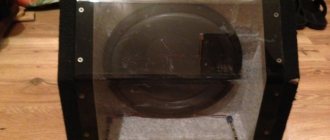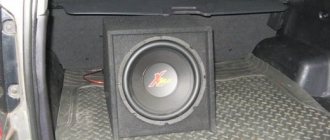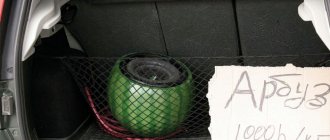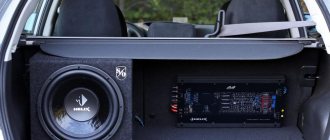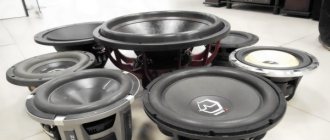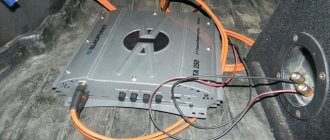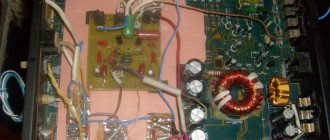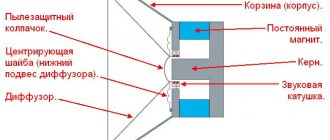The acoustics of a computer or music center are not capable of completely immersing its owner in the sound environment, literally making you feel a musical concert or special effects of a film with your skin? The problem can be solved if you choose the right subwoofer. Today, many manufacturers offer such devices. The main thing is to know what parameters you need to pay attention to when purchasing.
What is a subwoofer and how is it different from a regular speaker?
A subwoofer is a specially designed device that solves one simple task: reproducing low frequencies. The human ear begins to perceive vibrations from 20 Hz. For particularly sensitive individuals, this figure may be lower.
The problem with conventional speakers is that they are technically incapable of reproducing low frequencies well. Despite the fact that the parameters indicated in the documentation state that the operating range is, for example, 20-45000 Hz, in practice two-way acoustics sound somewhat flat. This happens for the following reasons:
- No device is capable of showing the same efficiency over the entire range of possible frequencies. At the edges there is definitely a failure in the frequency response. Most modern devices are not capable of accurately reproducing frequencies up to 400 Hz.
- The diameter of the speakers of two-way speakers is insufficient for sudden pressure surges. This parameter creates a juicy and thick bass.
- When operating a wideband speaker, the frequency range is sharply narrowed. The signal is averaged due to the inertia of the membrane and the coil’s response is not fast enough. As a result, achieving rich bass is simply unrealistic.
The characteristics of a subwoofer clearly show how it differs from a speaker. Firstly, the device’s operating frequency range is forcibly cut off. For the average subwoofer model it is in the range of 40-200 Hz. Secondly, the product is equipped with a really large sound emitter. The diameter of the membrane can be 30-50 cm for models for home use and up to a meter for stage subwoofers.
Subwoofer design
It will not be possible to describe everything in as much detail as possible, and even in such a way that everyone can understand it. Not everyone understands such complex technology at the same level.
Note!
DIY induction heater - instructions on how to make a simple and powerful heaterDo-it-yourself sound amplifier: selection of materials and tools for making at home + step-by-step instructions for creating and assembling yourself
Do-it-yourself wind generator: step-by-step instructions for making a device at home, choosing materials and type of construction
In order to understand in more detail and understand the entire design of the speakers, sound cards, and various accessories included in the subwoofer, you should find special technological maps and diagrams on the Internet. This can be done on any thematic forum or resource, or simply on a random site on the Internet.
Such images describe in detail the structure and design of such equipment. There are symbols, arrows and explanations of all abbreviations.
In general, everything is done to make it as clear and accessible as possible for you to study this issue. It is better to take ready-made drawings and diagrams for a subwoofer than to do it yourself.
Types of subwoofers
The first thing you need to know about a subwoofer is that models can have different types of signal reception and processing.
- A passive subwoofer is a fairly simple device. It is equipped with a low-pass filter and a large speaker. To drive a passive model, you will need an amplifier whose power exceeds that of an acoustic loudspeaker by at least one and a half times (the recommended value). There is no signal processing or conversion other than frequency filtering in subwoofers of this type.
- Active brands of subwoofers do not require an external amplifier to operate. All electronics are already included in the engineering solution of the model. A speaker, control circuits, frequency filtering, and preliminary and final signal amplification are installed in the housing. The main advantage of an active subwoofer is that it can be easily integrated into an existing speaker system.
The choice of a subwoofer of one type or another depends, first of all, on the capabilities of the sound-reproducing device and the cooling conditions at the location of the model. For example, an active subwoofer is not suitable for a car. This product generates quite a lot of heat during operation; it cannot be installed in a limited, enclosed space.
But for an apartment or as an addition to existing acoustics, a passive subwoofer is not suitable. In most cases, a powerful amplifier is not available for it, and buying it separately is very expensive. Therefore, home users prefer active subwoofers.
Antiacoustics
This is a very important part when arranging a home theater and a subwoofer in particular. You need to create excellent anti-acoustics, especially if you do not live in your own house, but in an apartment building.
Neighbors may complain about the loud noise, and they have a right. Create high-quality sound isolation and watch TV shows and movies, listen to music as much as you want.
The first thing you need to stock up on to create proper sound insulation is special acoustic foam. This is a fairly popular material that musicians regularly use to decorate their home music studios.
It is characterized by high efficiency and low cost. You can find soundproofing foam on various Internet resources from third-party manufacturers, then the price will be even lower.
You can also upgrade the existing walls in your home so that they add anti-acoustics and sound insulation. There is a special ceiling shape design that cannot be installed at home, but if you spend money and order the design from professionals, you definitely won’t regret it.
Design solutions and their features
You can also select a subwoofer based on the design features of a particular model. All proposed technical solutions have a difference in sound. First of all, this is due to differences in the air movement pattern.
The closed subwoofer is completely sealed. It has a durable body with a built-in speaker. Typically these are passive models. The sound of a closed subwoofer is considered classic; the devices do not suffer from reverberation and do not resonate. The sound is minimally distorted.
But closed subs have one unpleasant feature for the user: the larger the speaker, the more power is needed to move its membrane with full amplitude. In practice, this means that as the diameter of the sound emitter increases, the requirements for an external amplifier grow exponentially.
Bass reflex subwoofers are the best choice for the home. These devices sound rich and bright. They are both active and passive. The mechanics of their operation are based on the reverse movement of air through the bass reflex when the membrane vibrates. As a result, there is no back pressure created and there is no need for a sharp jump in amplifier requirements as speaker diameter increases.
Bass reflex models are offered by numerous companies. They are really popular. But not a single product of this type is without its main drawback. With a powerful harmonic signal, resonance phenomena may occur. A company that produces really good bass reflex models provides either electronic circuits for damping the growing amplitude of oscillations, or the ability to regulate the length of the air return tube.
Bandpass subwoofers are the most technically advanced devices. They are expensive, but they sound really high quality. In addition, only such models are capable of truly pumping air, creating powerful, intense vibrations. The design of the subwoofer bandpass is a combination of a closed and bass reflex system. The device body is divided into two zones. A speaker is installed in the sealed part. The second chamber operates as a volume bass reflex with a resonator output tube.
Bandpass models also have disadvantages. Firstly, they are large, which is clear from the description of the design features. Secondly, they, like closed systems, place exponentially growing demands on the external amplifier as the diameter of the speaker increases. The ideal solution when purchasing a subwoofer bandpass is to consider active types of devices.
If you need to choose a subwoofer for your car, it is recommended to choose the so-called FreeAir devices. They implement the operation scheme of a closed system with an air chamber. These types of subwoofers sound good when installed in the trunk and can use the interior space to generate deep bass. At the same time, the machine does not experience any vibrations that could affect the durability of the structure or the functioning of important systems.
Shield
In addition to the standard subwoofer device, it can be made in the form of an acoustic screen. To carry out this procedure, you will need a special tool called a shield.
But there is a catch - you can do this with your own hands at home only if the cladding of your walls is quite stable and made of high-quality materials.
Note!
Do-it-yourself incubator: a step-by-step master class on how to build it yourself, choosing building materials and type of constructionDo-it-yourself cyclone: methods for assembling the device at home, preparing materials and tools + step-by-step instructions
DIY Bluetooth speaker - step-by-step master class on making and installing it yourself, necessary materials and tools
Otherwise, due to the high bass content, problems may arise with this and you will have to spend money on repairs. Do-it-yourself shield or sub is very risky, but if you do everything correctly, the final result will definitely surprise you.
Specifications
When choosing a subwoofer model in a store, you can either trust the average recommendations or focus on your favorite music or the familiar sound environment in films. The choice is made according to the following parameters:
- the frequency range must be declared no higher than 160 Hz. In practice, the upper frequency limit will be higher. However, the average value at the declared value does not exceed 200 Hz, which is considered normal;
- The cutoff frequency parameter sets the range limit above which the signal will be forcibly suppressed. It would be ideal to select a model with adjustment of this indicator. Products with a rigidly defined boundary, the adjustment of which is not provided, must be characterized by a declared cutoff frequency of 160-200 Hz;
- sound pressure - this parameter well characterizes the movement of the speaker membrane. It characterizes the maximum volume, but does not necessarily directly correlate with the power of the subwoofer;
- sensitivity is responsible for the speed of the system's response to signal fluctuations. The higher this parameter, the easier it is for the amplifier to work. There is also the opposite rule: a high sensitivity value means that the speaker will respond to noise and interference. The sound quality drops especially sharply if the signal source is a player that decodes MP3 or other compressed files. The normal parameter, if we are considering a car type of subwoofer, is 90 dB, for a home system - from 100 to 150 dB.
- the remaining important parameters are the diameter of the speaker in millimeters and the electrical resistance of the system. With the first, everything is clear: the larger the membrane, the more intense the air shocks during its operation. You need to pay attention to the electrical resistance of the subwoofer if you need to match it to the speakers. It is desirable that the parameters of the existing acoustics and the selected product are the same.
The last step is to select a design solution. It is worth remembering that bass reflex subs are relatively inexpensive and undemanding. But closed and bandpass systems need to be chosen wisely, focusing on results and armed with a large amount of knowledge. Or - using the help of specialists.
Designing a subwoofer enclosure
Before you start purchasing materials and start working on how to make a subwoofer with your own hands, you need to design and roughly estimate the design and shape of the main part of the subwoofer - the housing.
The design of the case is divided into two main stages, each of which should be done as thoroughly and carefully as possible in order to ultimately obtain a high-quality product:
- Establishment and approval of Thiel-Small parameters for the loudspeaker
- Program for calculating acoustic designs
Other tools, such as a subwoofer box, can also be made by yourself.
All of the above can be purchased at almost every electronic goods store. Everything is installed according to the instructions that come with all components. Everything is written quite clearly and even a layman can figure it out and install everything without errors or breakdowns.
The main thing is to follow all the rules and do it carefully and carefully in order to make a high-quality subwoofer for the home with your own hands.
The best manufacturing companies
It is quite difficult to name the best subwoofer manufacturing companies. These devices, due to their characteristics, are developed for specific applications. Therefore, a company that produces stage subs or models for stadium concerts may not even offer products for home users. However, it is quite easy to name interesting favorites.
- Cabasse is a company that produces both stage devices and subs for home users. A striking example of products in the latter category is the Saturn 55. This is a real monster. The body weighs almost 200 kg, has a working volume of 500 liters, and the speaker weighs 27 kg. For all its monstrosity (including stylish decorative metal rod ties on the front panel), the device is perfectly balanced. When playing at maximum volume, the light steel pin mounted on top of the case does not even move.
- Yamaha. This company's products are expensive. However, the manufacturer is a world leader in developing systems with ideal sound. The range includes both active and passive subwoofers. The company's electronic circuits are the standard for quality and minimal signal distortion.
- Pioneer. A brand with a long history of decline and rise in popularity. However, one thing remains unchanged: the company has extensive experience in developing audio signal conversion systems. The range of offers includes any type of subwoofer, both for home and professional use.
- The last participant in the list of the best is the JBL brand from HARMAN. He has been developing acoustics and audio electronics for over 70 years. Today in the produced line of models you can find any type of subwoofer.
Filters
Yes, installing filters is not a necessary procedure if you are going to use the subwoofer in a country house, where no one will hear and you will not disturb anyone. In addition, filters prevent certain sound defects caused by excessive bass or too loud sound effects.
Subwoofer filters are a fairly affordable and inexpensive accessory that almost everyone can afford. Similar items are sold in a special themed music equipment store.
If there is no such store in your city, then try to find music filters in an electrical and computer instrument store.
Filters are necessary for the proper functioning of a homemade subwoofer.
How to choose a device
This may seem strange, but the people who have the most difficulty choosing a subwoofer are those buying a device for home use. There are many reasons for this:
- you need to take into account the limited volume of the room, reflections from the walls and the short distance to the listener;
- it is necessary to calculate the power in order to ideally fit the sub into an existing speaker system;
- for audiophiles, in addition to the above, it is important to coordinate the signal phasing and other parameters for truly ideal sound.
To make choosing the best model easier, here are some tips.
- For a small room up to 20 sq.m, it is recommended to buy a closed subwoofer. It minimally distorts the sound and does not create sudden air blasts. A bass reflex sub sounds good in a medium-sized room. In addition, it is more affordable than other solutions. And for a large room, with a certain thickness of the wallet, it is recommended to purchase a bandpass or strip model.
- The power of the subwoofer should be at least one and a half times the total power of the front speakers of the home theater. It is advisable to have a double supply. This will allow the speaker not to work at the limit, ensuring sound transmission without distortion. So, for 50 W speakers, it is advisable to buy a subwoofer with a power of 150 W or more.
- The sub should be positioned in such a way as to minimize wave overlap after reflection from the walls. The ideal place for it is in the corner. In this case, the wave reflected from the walls will have minimal delay from the main front of the oscillations generated by the device.
- Impedance, or electrical resistance of a subwoofer, is an important parameter when purchasing a passive model. It must match the corresponding characteristic of the other speakers for normal operation of the amplifier and predictable adjustments.
- The subwoofer must have its own volume control. Without this element of the design solution, it is very difficult to calculate the operation of the entire system as a whole.
Audiophiles are advised to buy sophisticated devices. The subwoofer must have an adjustable cutoff frequency. Ideally, the device allows you to adjust the phase shift. Using these functions, you can select subwoofer parameters for the ideal sound of the entire system.
Making computer calculations
Quite an important part of installing your own subwoofer. You should not rely one hundred percent on the devices and tools that you purchased. To be completely sure and confident that your home theater is working properly, you need to make preliminary computer calculations.
Computer programs do not provide for non-trivial solutions and errors that are typical for humans. This eliminates almost all risks and the possibility of error.
JBL subwoofers often use a computer plugin called JBL SpeakerShop. A fairly high-quality program that has wide functionality and runs smoothly even on the weakest computers and laptops.
Periodically, it is worth installing such software and checking the operation and functioning of all components of speakers and subwoofers.
LOVE STATISTICS
In October 2004, we for the first time began to measure the frequency response by sound pressure in the interior of cars included in the “Systems” section. Measurement data has been and continues to be accumulated in the form of files in the format of the Phonic PAA2 analyzer, which, among other things, has the ability to average the measured characteristics. And so we decided to see what the frequency response would look like, which is a synthesis of the activities of professional installers over a year and a half. The voice of the people is the voice of God; during averaging, numerous individual characteristics and/or flaws should have been smoothed out as statistical noise, and general trends should have appeared. So here it is: for the first time, the frequency response is published, obtained on the basis of approximately 80 frequency characteristics taken over a year and a half.
The result of averaging the frequency response in the cabin for approximately 80 professional audio systems, paid for and accepted by customers. Individual characteristics were leveled out, and it became clear: people want to see approximately this frequency response in their car. But you won’t go against the people, and there’s no point in doing so
It turned out to be a curious picture, a reason to think about the morals prevailing in society. But we will now focus on the low frequency region. General trend: people want to have sound pressure at low frequencies significantly higher than at mid frequencies. If they didn’t want to, they wouldn’t have had such frequency response done. Using other functions of PAA2, we even isolated the deviation of the frequency response at low frequencies from the horizontal straight line. At a frequency of 40 Hz, the increase in the “folk” frequency response was more than 14 dB. What does this mean? Let's assume that you have such magical midbass that they are capable of providing a smooth frequency response up to 40 Hz. And now the power supplied to them is only, say, 5 W. To achieve such a boost in bass, at 40 Hz the power supplied to the speakers must be approximately 25 times greater. Not 5 W, but 120 - 130. Really? No, of course, with normal 6-inch speakers the thermally permissible power is even lower, and long before that the distortion will exceed all conceivable limits. That is why this part of the frequency spectrum in a car is played by a specialized speaker, for which a hundred watts is not a disaster, but normal operation.
In order to focus in this conversation on low frequencies, we have isolated the low-frequency region from the graph of the “national” frequency response in the form of a deviation of the frequency response from the horizontal. It’s hard not to notice that below 80 Hz the tastes of car audio lovers crystallized into a dome-shaped frequency response with a maximum at 40 Hz
By the way, we couldn’t resist and performed the same operation, leaving in the sample only the cars that took high places in car audio competitions. As expected, the “average champion” frequency response looks much more modest than the “national” one.
The approach to bass topics of super-professionals - winners of high-ranking car audio competitions - is more restrained. In everyday life, the sound of the bass of many competitive cars is considered a bit dry, but it is precisely this that is most correct and reliable
By leaving in the sample only those systems in which the subwoofer was designed according to the principle of a closed box, and not a bass reflex, we confirmed what we already knew: it is the WY that gives the most even frequency response. With the right choice of parameters, of course
Those familiar with past issues of “V.V.” We should have noticed signs of some deceit in the above logic. Indeed, there is a transfer function of the interior, thanks to which it is in the car (that is, where the masses demand it) that the frequency response, starting from a certain frequency, rises by itself, without any human intervention. It’s good that you really noticed the transfer function of the cabin - a true blessing from God for car audio enthusiasts; without it, it would have been incredibly difficult to obtain the desired characteristic even with the help of a subwoofer, and at high volume levels (let’s not forget about this taste feature) - and completely impossible. However, the fact of the presence and uninterrupted operation of the transfer function does not eliminate the need for a separate bass section, but simply imposes certain requirements on its design and calculation. Or do we need to remind you about the transfer function? Now is the time, there’s no way to continue without her.


